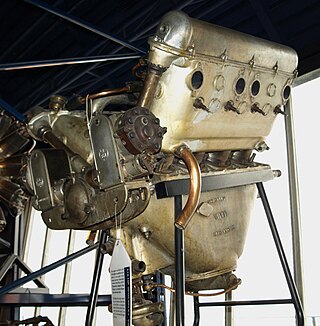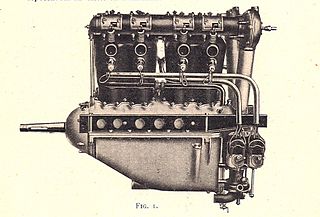
The Hispano-Suiza 8 was a water-cooled V8 SOHC aero engine introduced by Hispano-Suiza in 1914, and was the most commonly used liquid-cooled engine in the aircraft of the Entente Powers during the First World War. The original Hispano-Suiza 8A was rated at 140 hp (100 kW) and the later, larger displacement Hispano-Suiza 8F reached 330 hp (250 kW).

The Sunbeam Sikh was a large slow running V-12 piston engine, intended to power airships, under development at the time of the Armistice.

The Wolseley Viper is a British-built, high-compression derivative of the Hispano Suiza HS-8 liquid-cooled V-8 engine, built under licence by Wolseley Motors during World War I.

The Sunbeam Dyak was a British inline six-cylinder, water-cooled, twin updraft carburettor engine.
The Sunbeam Crusader, originally known as the Sunbeam 150 hp, Sunbeam 110 hp or Sunbeam 100 hp, was an early British, side-valve, water-cooled, V-8 aero engine first marketed in 1913.

The Klimov M-103 is a V12 liquid-cooled piston aircraft engine used by Soviet aircraft during World War II.

The Renault 8G was a family of French liquid-cooled V-8 aero engines of the World War I era that produced from 140 hp (100 kW) to 190 hp (140 kW).

The Sunbeam Matabele was a British 12-cylinder aero engine that was first flown in 1918. The Matabele was the last iteration of one of Sunbeam's most successful aero engines, the Cossack.

The Sunbeam Manitou was an aero-engine produced by Sunbeam. Unsuccessful as an aero-engine, it is best known for having powered the Sunbeam 350HP racing car.
The ABC Mosquito was a 120 hp (90 kW) six-cylinder radial aero engine designed by the noted British engineer Granville Bradshaw for use in light aircraft. The single Mosquito engine was built by ABC Motors, first running in 1916. It is thought that the design resulted from a bet between Harry Hawker and Bradshaw, Hawker proposing that Bradshaw could not build and fly a six-cylinder radial engine. The Mosquito used copper-plated steel Gnat cylinders. The engine was not a success.
The ADC Nimbus was a British inline aero engine that first ran in 1926. The Nimbus was developed from the Siddeley Puma aero engine by Frank Halford of the Aircraft Disposal Company, the goal was to develop the Puma to produce its intended power output which Halford eventually achieved. The Nimbus was further developed into an air-cooled version known as the ADC Airsix which did not enter production and was not flown.

The Beardmore 120 hp was a British six-cylinder, water-cooled aero engine that first ran in 1914, it was built by William Beardmore and Company as a licensed-built version of the Austro-Daimler 6. The engine featured cast iron cylinders and mild steel concave pistons. Produced between August 1914 and December 1918, the design powered many World War I aircraft types.

The Beardmore 160 hp is a British six-cylinder, water-cooled aero engine that first ran in 1916, it was built by Arrol-Johnston and Crossley Motors for William Beardmore and Company as a development of the Beardmore 120 hp, itself a licensed-built version of the Austro-Daimler 6.
The Sunbeam Pathan, also known as the Sunbeam P.1, was a 1920s British diesel aero engine.

The Sunbeam Cossack was a British 12-cylinder aero engine that was first run in 1916. The Cossack spawned a family of engines from Sunbeam.
The Sunbeam Afridi was an aero-engine produced by Sunbeam during the First World War.
The Sunbeam Nubian, also called the Sunbeam 155 hp, was a British 8-cylinder aero-engine that was first run in 1916.
The Sunbeam Spartan was a British 12-cylinder aero-engine designed and built in 1916.

The Walter Junior was a family of four cylinder air cooled horizontally-opposed engines produced by Walter Aircraft Engines in Czechoslovakia in the 1930s for aircraft, characterised by a bore and stroke of 115 mm × 140 mm, a displacement of 5,814 cm3 (354.8 cu in) and producing roughly 78 kW (105 hp).












